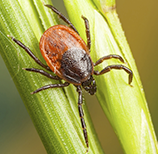Rocky Mountain spotted fever (RMSF) is a zoonosis which means it can be spread between animals and humans. Many such zoonotic diseases are transmitted through insects like mosquitoes and ticks. RMSF is caused by a very small type of bacteria called Rickettsia rickettsii which is injected into people and dogs by feeding ticks. However, direct transmission of organisms from dogs to people is not known to occur.
Once established inside the animal, the rickettsial organisms cause damage and inflammation in tiny blood vessels resulting in the ‘spots’ referred to in the common name for the disease. These little areas of hemorrhage are often visible on the skin but they also occur in other internal organs like the heart, brain and kidney and can result in serious, potentially life-threatening/fatal illness.
The incubation period from infection to onset of clinical signs can vary from just a few days to two weeks; often times the connection may not be made between the presence of a tick and the later development of illness.
Symptoms of Rocky Mountain spotted fever
Symptoms can be very non-specific in dogs and in people:

- Fever
- Nausea
- Vomiting
- Lack of appetite
- Muscle pain
Diagnosing Rocky Mountain spotted fever
True diagnostic testing is based on demonstrating RMSF DNA in the patient’s blood by polymerase chain reaction (PCR) testing. Serology, which tests for a rising immune response over time, can also be performed. That means the results are not available until well into the illness. Unfortunately, Not every patient develops a rash, and when they do it is often a few days after they become clinically ill.
Treatment of Rocky Mountain spotted fever
Since treatment with the antibiotic doxycycline is most effective when started before the fifth day of symptoms, any delay in diagnosis and treatment can be profoundly significant in terms of outcome and prognosis. As a result, treatment is typically instituted based on clinical symptoms, location, and risk of exposure alone (with or without known tick bites).
What regions are at risk for Rocky Mountain spotted fever?
First and foremost, do not let the name of the disease fool you into a false sense of security based on where you live. Even though the disease was first recognized in the Rocky Mountains, only a small percentage of all cases are now found there. The CDC says, “RMSF cases have been reported throughout most of the contiguous United States, with five states (North Carolina, Oklahoma, Arkansas, Tennessee, and Missouri) accounting for over 60% of RMSF cases.” Also, while according to the CDC “the proportion of RMSF cases resulting in death has declined to a low of less than 0.5, the incidence of the disease itself has increased during the last decade.”
Prevention of Rocky Mountain spotted fever
Tick control and prevention of transmission are your best defense for both you and your pet. The Companion Animal Parasite Council recommends that, "all dogs be maintained year round on tick control products.” (See your veterinarian about what to use for your particular pet.) In addition tick control efforts can be aided by removing tick habitats around the home:
- Trim brush
- Clip grass
- Remove leaf litter
- Exclude wildlife by installing fencing and removing debris
- Limit contact with infested areas by preventing roaming in dogs
Of course, you should always carefully check your pets, yourselves, your clothing, and your belongings for ticks.
The timely removal of ticks is absolutely essential in preventing RMSF because, unlike other tick borne illness, e.g., Lyme or ehrlichia where the ticks need to be feeding for approximately 24-48 hours before transmitting infectious organisms, with RMSF “transmission generally occurs 5 to 20 hours after tick attachment,” says capcvet.com. Tick removal and handling must be done very carefully because the rickettsial bacteria can also be transmitted through fluids, tissues, blood, or feces through cuts or sores on your skin.
In conclusion, RMSF is a serious, sometimes fatal illness for both dogs and people that occurs to some degree in most areas of the United States. Because it can be difficult to diagnose early enough for effective treatment, the best defense is to guard against exposure in the first place.
[Editor's Note: Annual testing is important to protect your dog from ticks. Learn more here.]
If you have any questions or concerns, you should always visit or call your veterinarian – they are your best resource to ensure the health and well-being of your pets.
Beware the Bug By Dr. Ruth MacPete Anaplasma is spread by ticks. As the weather gets warmer and dogs spend more time outside, they’re more likely to be exposed to these creepy parasites and all of the diseases they carry. Read more> Or learn more about dogs and parasites > |

